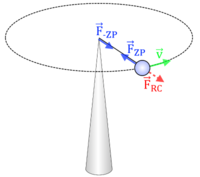当前位置:
X-MOL 学术
›
Phys. Rev. Phys. Educ. Res.
›
论文详情
Our official English website, www.x-mol.net, welcomes your feedback! (Note: you will need to create a separate account there.)
Students’ understanding of non-inertial frames of reference
Physical Review Physics Education Research ( IF 3.1 ) Pub Date : 2020-03-24 , DOI: 10.1103/physrevphyseducres.16.010112 S. Küchemann , P. Klein , H. Fouckhardt , S. Gröber , J. Kuhn
Physical Review Physics Education Research ( IF 3.1 ) Pub Date : 2020-03-24 , DOI: 10.1103/physrevphyseducres.16.010112 S. Küchemann , P. Klein , H. Fouckhardt , S. Gröber , J. Kuhn

|
The concepts of the Coriolis and the centrifugal force are essential in various scientific fields and they are standard components of introductory physics lectures. In this paper, we explore how students understand and apply concepts of rotating frames of reference in the context of an example lecture demonstration experiment. We found in a predict-observe-explain setting that after predicting the outcome prior to the demonstration, only one out of five physics students correctly reported the observation of the trajectory of a sphere rolling over a rotating disc. Despite this low score, a detailed analysis of distractors revealed a significant improvement in the distractor choices during the observation of the experiment. In this context, we identified three main preconceptions and learning difficulties: The centrifugal force seems to be only required to describe the trajectory if the object is coupled to the rotating system, the inertial forces cause a reaction of an object on which they act, and students systematically mix up the trajectories in the stationary and the rotating frame of reference. Furthermore, we captured students’ eye movements during the predict task and found that physics students with low confidence ratings focused longer on relevant task areas than confident students despite having a comparable score. Consequently, this metric is a helpful tool for the identification of preconceptions using eye tracking. Overall, the results help us to understand the complexity of concept learning from demonstration experiments and provide important implications for instructional design of introductions to rotating frames of reference.
中文翻译:

学生对非惯性参考系的理解
科里奥利和离心力的概念在各个科学领域中都是必不可少的,它们是物理入门课程的标准组成部分。在本文中,我们将通过示例演示实验来探讨学生如何理解和应用旋转参考系的概念。我们发现了一个预测观察的解释设置为在演示之前预测结果之后,只有五分之一的物理学生正确地报告了在旋转圆盘上滚动的球体的轨迹的观察结果。尽管得分很低,但对干扰物的详细分析显示,在观察实验过程中,干扰物的选择有显着改善。在这种情况下,我们确定了三个主要的概念和学习困难:如果物体与旋转系统耦合,似乎仅需要离心力来描述轨迹,惯性力会引起物体对其作用的反应,并且学生系统地将静止和旋转参照系中的轨迹混合在一起。此外,我们在预测任务期间捕获了学生的眼球运动,发现尽管得分相当,但低自信等级的物理学生比自信学生专注于相关任务领域的时间更长。因此,该指标是使用眼动追踪识别先入为主的有用工具。总体而言,结果有助于我们从演示实验中了解概念学习的复杂性,并对旋转参考系的介绍的教学设计提供重要启示。
更新日期:2020-03-24
中文翻译:

学生对非惯性参考系的理解
科里奥利和离心力的概念在各个科学领域中都是必不可少的,它们是物理入门课程的标准组成部分。在本文中,我们将通过示例演示实验来探讨学生如何理解和应用旋转参考系的概念。我们发现了一个预测观察的解释设置为在演示之前预测结果之后,只有五分之一的物理学生正确地报告了在旋转圆盘上滚动的球体的轨迹的观察结果。尽管得分很低,但对干扰物的详细分析显示,在观察实验过程中,干扰物的选择有显着改善。在这种情况下,我们确定了三个主要的概念和学习困难:如果物体与旋转系统耦合,似乎仅需要离心力来描述轨迹,惯性力会引起物体对其作用的反应,并且学生系统地将静止和旋转参照系中的轨迹混合在一起。此外,我们在预测任务期间捕获了学生的眼球运动,发现尽管得分相当,但低自信等级的物理学生比自信学生专注于相关任务领域的时间更长。因此,该指标是使用眼动追踪识别先入为主的有用工具。总体而言,结果有助于我们从演示实验中了解概念学习的复杂性,并对旋转参考系的介绍的教学设计提供重要启示。


























 京公网安备 11010802027423号
京公网安备 11010802027423号